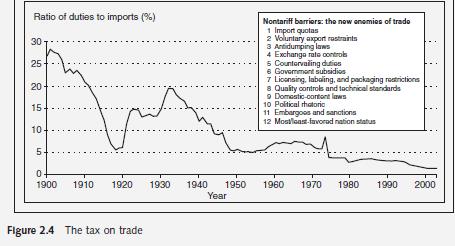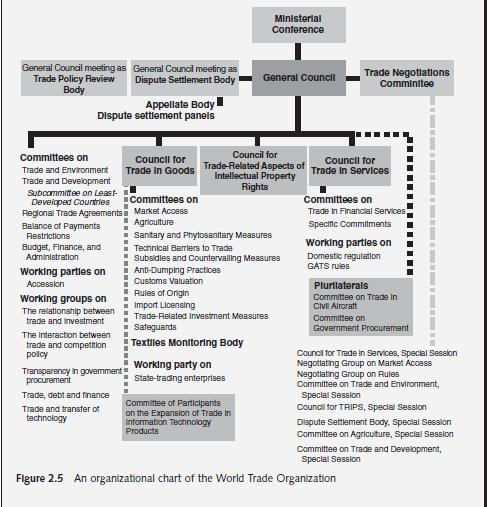The essential difference between free trade and protection is this: Under a system of free trade excellence
Question:
The essential difference between free trade and protection is this: Under a system of free trade excellence of the product is the only means by which it can secure a market, while under protection an inferior article can dominate the market through the aid of legislation. The necessary effect of free trade is, therefore, to encourage efficiency in production, while the necessary effect of protection is to encourage skill in corruption. Prosperity is an abundance of commodities.
The merit of any policy or system can be tested by its effect on the volume of commodities available for the use of the people.
William Bourke Cockran, In the Name of Liberty, 1925 In 1947, in Geneva, 23 countries signed the General Agreement on Tariffs and Trade (GATT), a voluntary association of countries designed to promote free trade. GATT members have held many talks since 1947 to expand and promote world trade. As shown in figure 2.3, such talks have resulted in vast tariff reductions for industrialized countries. Many developing countries have implemented similar tariff reductions. These tariff reductions have caused world trade to increase twice as fast as world output since 1950, thereby boosting the standard of living for millions of people around the world.

The general trend around the world since World War II has been to reduce obvious trade barriers, such as tariffs. Tariff reductions through several rounds of trade negotiations are an indication not only that countries are committed to working jointly toward freer trade but also that tariffs are the easiest trade barrier to tackle. In addition, negotiating rounds have dealt with the increasingly important and complex nontariff issues. Nevertheless, many governments have replaced obvious trade barriers with less obvious forms of protection. A growing number of nontariff barriers, such as those shown in figure 2.4 and others, threaten to undo the good work.
The biggest change to emerge from the Uruguay Round of trade negotiations (1986–93)
was the agreement to replace the GATT with the World Trade Organization (WTO). Under the WTO, there is a clearly defined dispute-settlement mechanism. This dispute-settlement system allows small and developing countries to have an influence for the first time in dealing with trade practices in other countries. Further, by bringing cases to the panel, accused countries may agree to settle before a ruling is made. Consequently, the WTO’s settlement body has had a much heavier caseload than existed under the old GATT system. China joined the WTO in 2001, thereby further legitimizing the idea of free trade. As of January 2003, the WTO consisted of 144 countries and 34 observer countries, all of which are in the process of applying for membership. Based in Geneva, Switzerland, the WTO has a staff of 550 individuals Reduced tariff rates lowered trade barriers and helped stimulate economic growth in recent decades. A growing number of nontariff barriers, however, threaten to undo the good. Voluntary export restraints; antidumping laws; government subsidies; licensing, labeling and packaging restrictions; domestic-content laws and others have emerged as the new enemies of free trade

from 60 different countries and a budget of 143 million Swiss francs. Today, WTO members account for 97 percent of world trade.
The WTO is a consensus-based organization: decisions are made by the entire membership.
A majority vote is also possible, but it has never been used in the WTO and was extremely rare under the WTO’s predecessor, GATT. The WTO’s agreements have been ratified in all of the members’ legislative bodies. As shown in figure 2.5, the WTO’s top-level decision-making body is the Ministerial Conference, which meets at least once every two years. There have been five WTO Ministerial Conferences so far, held in Cancun, Mexico (November 2003), Doha, Qatar (November 2001), Seattle, Washington (November 1999), Geneva, Switzerland (May 1998), and Singapore (December 1996).
Below the Ministerial Conference is the General Council, which meets several times a year in the Geneva headquarters. The General Council also meets as the Trade Policy Review Body and the Dispute Settlement Body. At the next level, the Goods Council, the Services Council, and the Intellectual Property Council report to the General Council and meet frequently. At the last level, numerous specialized committees, working groups, and working parties deal with the individual agreements and other areas such as the environment, development, membership applications, and regional trade agreements.
The WTO Secretariat, with offices only in Geneva, is headed by a Director-General. Because decisions are only made by members, the Secretariat has no decision-making powers. Its main

duties are to supply technical and professional support for the various councils and committees, to provide technical assistance for developing countries, to monitor and analyze developments in world trade, to provide information to the public and the media, and to organize the ministerial conferences. The Secretariat also provides some forms of legal assistance in the dispute settlement process and advises governments wishing to become Members of the WTO.
Case Questions 1 What are the main responsibilities of the WTO and what enforcement powers does it have?
2 What are the reasons for protectionism? Would the World Trade Organization consider any of them justified?
3 Many countries have begun to use less obvious trade barriers as a form of protection. What are these different approaches and how do they make the WTO’s ability to monitor trade more difficult?
4 Free trade is a highly political issue. Why do you think this is? What steps can be taken to unpoliticize this issue?
5 During the past decade, the WTO has been subject to fierce criticism and attention-grabbing protests from a variety of political and social groups. Complete some independent research on these protests. What are the main criticisms of the WTO that these groups have? Do you think they are justified?
6 The website of the World Trade Organization, www.wto.org, contains a range of information about WTO activities. Use this website to find out what steps the WTO has taken to respond to the protests and criticism. Do you think that these steps are effective?
Step by Step Answer:

Global Corporate Finance Text And Cases
ISBN: 9781405119900
6th Edition
Authors: Suk H. Kim, Seung H. Kim





